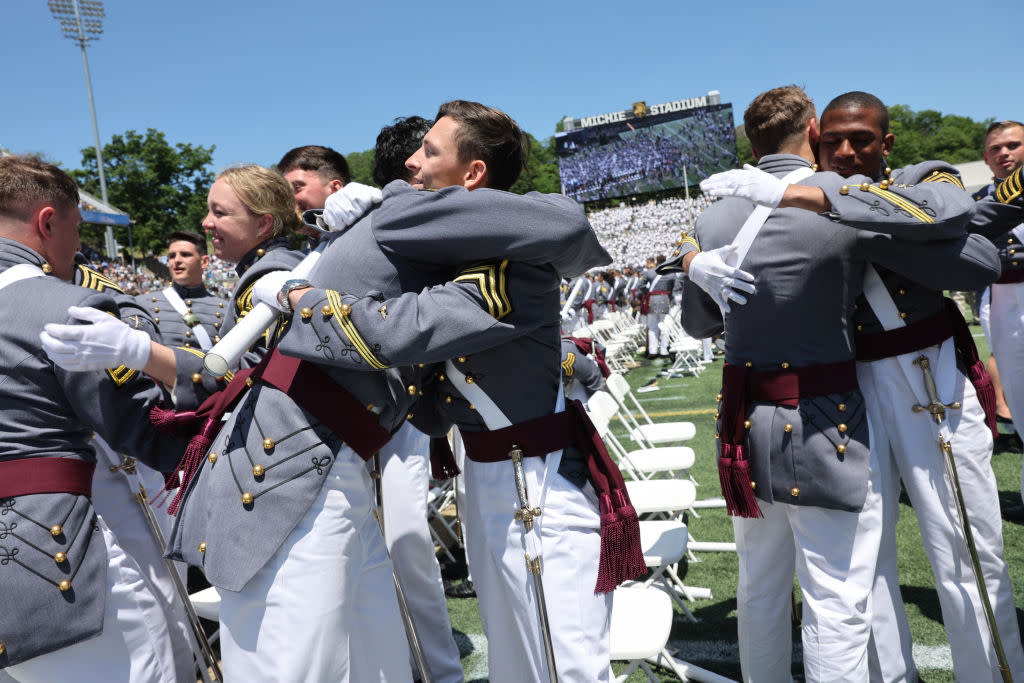Affirmative Action Still an Option at West Point, But Supreme Court Likely to Have Final Say

Cadets celebrate at Michie Stadium at West Point's graduation on May 27, 2023 in West Point, NY Credit - Spencer Platt—Getty Images
This article is part of The D.C. Brief, TIME’s politics newsletter. Sign up here to get stories like this sent to your inbox.
Amid the flurry of dramatic rulings the Supreme Court’s nine justices handed down last month right before ditching D.C. until October, there was an under-appreciated footnote that merits a second reading. In the blockbuster decision that essentially ended the use of race in college admissions, Chief Justice John Roberts gave U.S. military academies a carve-out.
Put simply: West Point can keep using affirmative action but Harvard cannot, and students of color worried that the challenges of getting into their preferred school now seem insurmountable might want to consider how they look in uniform.
The rationale, co-signed by the Court’s six-strong conservative majority, carries inherent problems, and there is little doubt the ruling will be revisited. In the meantime, it seems as if the court was simply punting with the June 29 ruling on something that clearly is going to define part of its legacy.
“No military academy is a party to these cases, however, and none of the courts below addressed the propriety of race-based admissions systems in that context,” Roberts wrote in a note at the bottom of page 30 of 237, tacitly acknowledging and then dismissing arguments that affirmative action helped diversify the military’s leadership. “This opinion also does not address the issue, in light of the potentially distinct interests that military academies may present.”
Those “distinct interests”—namely having a leadership corps in the national security space that reflects all parts of the society it is built to defend—may be worth considering under different circumstances, the justices conceded. But as it stands, the court essentially bought for now the argument that issues facing military academies were beyond the scope of cases about Harvard and the University of North Carolina and that increasing diversity in our armed forces may be in the national interest. Implied in that posture is the notion that increasing diversity in other, bigger parts of society is not. Got it?
The elite military academies are already some of the most selective institutions in the country and create a pipeline for a generation of national security leadership. Fewer than one-in-five applicants get invited, and the application process is one the toughest out there even before that. While anyone with $85 can apply to Harvard (acceptance rate: 4%), applicants to four of the five academies need to persuade their member of Congress to nominate them for a finite number of slots. That, of course, comes with its own political dynamics, further complicating the screening process for what is essentially the toughest H.R. interview in federal service.
For anyone who’s been around Washington for a minute, the ruling didn’t come as a complete surprise. For good or ill, anything linked to the military is seen in some corners of D.C.’s elite class as sacrosanct. Budget cuts at the Pentagon are all but verboten in even fiscal hawks’ dens. Whenever there are talks of across-the-board reductions in spending, everyone trips over themselves to point out that they’re talking about “non-defense spending,” and the good folks in the military-industrial complex shouldn’t lose any sleep. It’s a combination of respect for the troops and fear of the defense lobbyists on K Street who are quite adept at casting any skepticism about military spending as disloyalty. This court’s decidedly conservative tilt was not about to wade into that space at the moment.
At the Capitol, the ruling sparked predictable outrage among liberals and giddy gloating from conservatives. Without much real recourse, Democrats bemoaned the double-track that, to channel Justice Ketanji Brown Jackson’s dissent, values racial diversity in bunkers but not boardrooms. To their dismay, liberals read the ruling as telling the country that diversity matters only when it comes time to send men and women into war zones. And it further tells persons of color that they would do well to practice their marching skills if they want to enjoy any advantage that affirmative action may offer.
Across the aisle, Sen. Roger Wicker, the top Republican on the Senate Armed Services Committee, has plans to ban remaining affirmative action programs as an amendment to the National Defense Authorization Act. House Republicans have similar plans to also eliminate the Pentagon’s diversity officer, funding for diversity, equity, and inclusion programs, and a review of existing programs in the name of combating perceived “wokeness.”
From 30,000 feet above the gorgeous campuses, the student populations at the academies have made strides at better reflecting their neighbors they’ll spend their careers protecting. At the U.S. Military Academy in West Point, N.Y., the ranks of cadets who identified as a racial or ethnic minority went from 20% in 2000 to 36% in 2021. At the U.S. Naval Academy in Annapolis, Md., that number rose from 19% percent to 37%. There are similar stories in the data from the Air Force and Coast Guard academies.
Still, enlisted and commissioned military members remain distinct worlds demographically. The military’s leadership is still overwhelmingly white and male in an institution that, historically, has been an instrument for social change. Roughly 90% of generals and admirals are white, although Defense Secretary Lloyd Austin is working on leveling that out.
All of that explains why there’s a good chance the court will find itself dealing with the specific issue of affirmative action at military academies in the future. Military leaders know that having military academies train diverse cohorts of graduates stands to pay dividends for decades. Now, that talent pipeline is back on conservative lawmakers’ agendas—and not necessarily in a good way.
Make sense of what matters in Washington. Sign up for the D.C. Brief newsletter.

